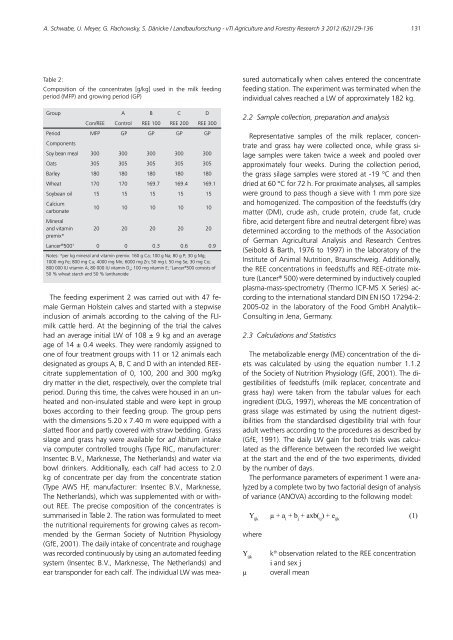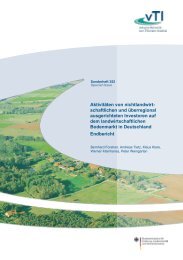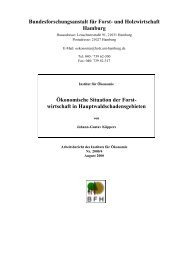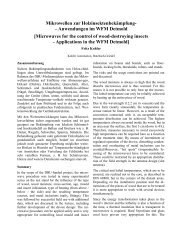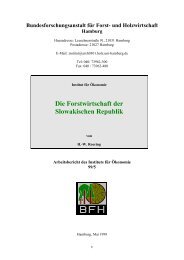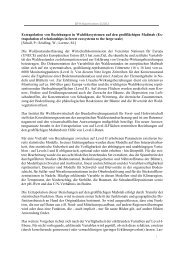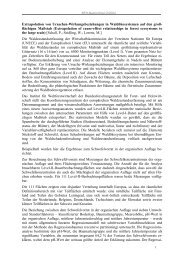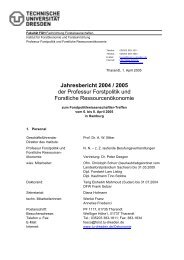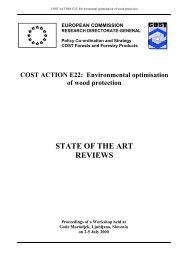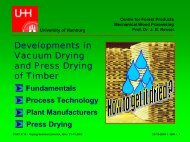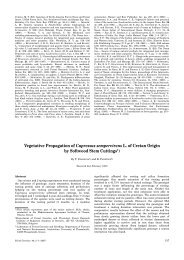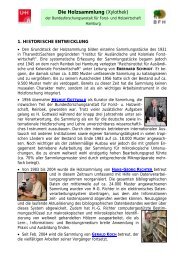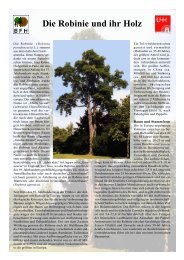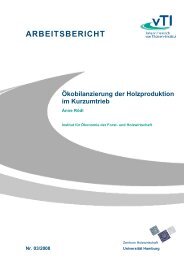Landbauforschung vTI Agriculture and Forestry ... - 1. Januar 2008
Landbauforschung vTI Agriculture and Forestry ... - 1. Januar 2008
Landbauforschung vTI Agriculture and Forestry ... - 1. Januar 2008
Create successful ePaper yourself
Turn your PDF publications into a flip-book with our unique Google optimized e-Paper software.
A. Schwabe, U. Meyer, G. Flachowsky, S. Dänicke / <strong>L<strong>and</strong>bauforschung</strong> - <strong>vTI</strong> <strong>Agriculture</strong> <strong>and</strong> <strong>Forestry</strong> Research 3 2012 (62)129-136 131<br />
Table 2:<br />
Composition of the concentrates [g/kg] used in the milk feeding<br />
period (MFP) <strong>and</strong> growing period (GP)<br />
Group A B C D<br />
Con/REE Control REE 100 REE 200 REE 300<br />
Period MFP GP GP GP GP<br />
Components<br />
Soy bean meal 300 300 300 300 300<br />
Oats 305 305 305 305 305<br />
Barley 180 180 180 180 180<br />
Wheat 170 170 169.7 169.4 169.1<br />
Soybean oil 15 15 15 15 15<br />
Calcium<br />
carbonate<br />
10 10 10 10 10<br />
Mineral<br />
<strong>and</strong> vitamin<br />
premix*<br />
20 20 20 20 20<br />
Lancer ® 500 † 0 0 0.3 0.6 0.9<br />
Notes: *per kg mineral <strong>and</strong> vitamin premix: 160 g Ca; 100 g Na; 80 g P; 30 g Mg;<br />
1000 mg Fe; 800 mg Cu; 4000 mg Mn; 6000 mg Zn; 50 mg I; 50 mg Se; 30 mg Co;<br />
800 000 IU vitamin A; 80 000 IU vitamin D 3 ; 100 mg vitamin E; † Lancer ® 500 consists of<br />
50 % wheat starch <strong>and</strong> 50 % lanthanoide<br />
The feeding experiment 2 was carried out with 47 female<br />
German Holstein calves <strong>and</strong> started with a stepwise<br />
inclusion of animals according to the calving of the FLImilk<br />
cattle herd. At the beginning of the trial the calves<br />
had an average initial LW of 108 ± 9 kg <strong>and</strong> an average<br />
age of 14 ± 0.4 weeks. They were r<strong>and</strong>omly assigned to<br />
one of four treatment groups with 11 or 12 animals each<br />
designated as groups A, B, C <strong>and</strong> D with an intended REEcitrate<br />
supplementation of 0, 100, 200 <strong>and</strong> 300 mg/kg<br />
dry matter in the diet, respectively, over the complete trial<br />
period. During this time, the calves were housed in an unheated<br />
<strong>and</strong> non-insulated stable <strong>and</strong> were kept in group<br />
boxes according to their feeding group. The group pens<br />
with the dimensions 5.20 x 7.40 m were equipped with a<br />
slatted floor <strong>and</strong> partly covered with straw bedding. Grass<br />
silage <strong>and</strong> grass hay were available for ad libitum intake<br />
via computer controlled troughs (Type RIC, manufacturer:<br />
Insentec B.V., Marknesse, The Netherl<strong>and</strong>s) <strong>and</strong> water via<br />
bowl drinkers. Additionally, each calf had access to 2.0<br />
kg of concentrate per day from the concentrate station<br />
(Type AWS HF, manufacturer: Insentec B.V., Marknesse,<br />
The Netherl<strong>and</strong>s), which was supplemented with or without<br />
REE. The precise composition of the concentrates is<br />
summarised in Table 2. The ration was formulated to meet<br />
the nutritional requirements for growing calves as recommended<br />
by the German Society of Nutrition Physiology<br />
(GfE, 2001). The daily intake of concentrate <strong>and</strong> roughage<br />
was recorded continuously by using an automated feeding<br />
system (Insentec B.V., Marknesse, The Netherl<strong>and</strong>s) <strong>and</strong><br />
ear transponder for each calf. The individual LW was mea-<br />
sured automatically when calves entered the concentrate<br />
feeding station. The experiment was terminated when the<br />
individual calves reached a LW of approximately 182 kg.<br />
2.2 Sample collection, preparation <strong>and</strong> analysis<br />
Representative samples of the milk replacer, concentrate<br />
<strong>and</strong> grass hay were collected once, while grass silage<br />
samples were taken twice a week <strong>and</strong> pooled over<br />
approximately four weeks. During the collection period,<br />
the grass silage samples were stored at -19 °C <strong>and</strong> then<br />
dried at 60 °C for 72 h. For proximate analyses, all samples<br />
were ground to pass though a sieve with 1 mm pore size<br />
<strong>and</strong> homogenized. The composition of the feedstuffs (dry<br />
matter (DM), crude ash, crude protein, crude fat, crude<br />
fibre, acid detergent fibre <strong>and</strong> neutral detergent fibre) was<br />
determined according to the methods of the Association<br />
of German Agricultural Analysis <strong>and</strong> Research Centres<br />
(Seibold & Barth, 1976 to 1997) in the laboratory of the<br />
Institute of Animal Nutrition, Braunschweig. Additionally,<br />
the REE concentrations in feedstuffs <strong>and</strong> REE-citrate mixture<br />
(Lancer ® 500) were determined by inductively coupled<br />
plasma-mass-spectrometry (Thermo ICP-MS X Series) according<br />
to the international st<strong>and</strong>ard DIN EN ISO 17294-2:<br />
2005-02 in the laboratory of the Food GmbH Analytik–<br />
Consulting in Jena, Germany.<br />
2.3 Calculations <strong>and</strong> Statistics<br />
The metabolizable energy (ME) concentration of the diets<br />
was calculated by using the equation number <strong>1.</strong><strong>1.</strong>2<br />
of the Society of Nutrition Physiology (GfE, 2001). The digestibilities<br />
of feedstuffs (milk replacer, concentrate <strong>and</strong><br />
grass hay) were taken from the tabular values for each<br />
ingredient (DLG, 1997), whereas the ME concentration of<br />
grass silage was estimated by using the nutrient digestibilities<br />
from the st<strong>and</strong>ardised digestibility trial with four<br />
adult wethers according to the procedures as described by<br />
(GfE, 1991). The daily LW gain for both trials was calculated<br />
as the difference between the recorded live weight<br />
at the start <strong>and</strong> the end of the two experiments, divided<br />
by the number of days.<br />
The performance parameters of experiment 1 were analyzed<br />
by a complete two by two factorial design of analysis<br />
of variance (ANOVA) according to the following model:<br />
Y ijk µ + a i + b j + axb( ij ) + e ijk (1)<br />
where<br />
Y k ijk<br />
th observation related to the REE concentration<br />
i <strong>and</strong> sex j<br />
µ overall mean


